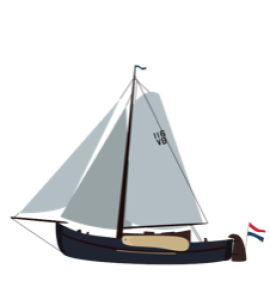A New Sailing Adventure: Tips for Beginner Sailors and Flat-Bottom Sailing on the Wadden Sea
Imagine: the wind in the sails, the splash of water, and the feeling of freedom as you hold the helm of a classic flat-bottomed boat on the vast Wadden Sea. As a beginner sailor, this might seem like a dream, but with the right knowledge and some practice, you can make this experience a reality. In this blog, we share the basics of sailing and some handy tips for novice sailors, including how to sail a flat-bottomed boat on the Wadden Sea.

Sailing Basics
Sailing is an ancient art that revolves around harnessing the wind to propel a boat. Here are some essential concepts you need to understand:
Wind Directions: Learn the different wind directions such as close-hauled, beam reach, and run. This affects how you trim the sails.
Close-Hauled (Close to the Wind): Sailing close-hauled, also known as beating or close-hauled sailing, means sailing with the wind coming directly from the front, roughly within 45 degrees of the bow of your boat. This is one of the most challenging wind directions to sail in because the wind blows against your boat. You cannot sail directly into the wind as the sails will flap and the boat won’t move forward. Instead, you must follow a zigzag course, tacking back and forth across the wind, to make headway. The sails are pulled in tight to catch the wind and keep the boat moving.
Beam Reach: Sailing on a beam reach means the wind is coming from the side of the boat, roughly between 90 and 135 degrees from the bow. This is a comfortable wind direction as the wind pushes your boat from behind. The sails are still tight but slightly more open to capture the wind better. Beam reaching provides speed and stability, making it a good opportunity to relax and enjoy sailing.
Run: Sailing downwind or running is when the wind comes directly from behind, approximately within 135 degrees from the bow. This is the easiest and fastest way to sail because the wind pushes your boat from behind. In this wind direction, the sails are fully out, meaning they are held on the opposite side of the boat to catch the maximum wind. Running can be very enjoyable but requires caution to prevent unexpected sail changes.
Understanding these wind directions is crucial for effective sailing. Depending on the wind direction, you adjust the position of your sails to achieve optimal performance. By learning the forces of the wind and how to harness them, you can master the art of sailing and enjoy adventurous journeys on the water. So, remember these important wind directions and get ready to hoist the sails and conquer the waves!
Trimming the Sails: Correctly adjusting the sails to make optimal use of the wind. Tighten them for higher speed and loosen for more control.
Rudder and Daggerboard: The rudder steers the boat, and the daggerboard provides stability. Learn how to use these to set your course.
Tacking and Jibing: These are maneuvers to change course. Tacking is turning with the wind, while jibing is turning against the wind.

The Beginning of an Adventure
As a beginner sailor, it’s important to learn step by step and build confidence. Whether you start on tranquil lakes or immediately embrace the challenge of the Wadden Sea, every sailing trip will be a unique and valuable experience. With the right knowledge, preparation, and a healthy dose of enthusiasm, you can enjoy the beauty of sailing and the freedom of the water. Remember, every adventure begins with a single step, or in this case, casting off a single line. Go for it and discover the exhilarating world of sailing!
Tips for Beginner Sailors:
-
Start with Lessons: Before sailing independently, consider taking a sailing course. This will provide you with basic skills and the confidence to sail safely.
-
Learn Water Rules: Familiarize yourself with water rules and right-of-way situations to avoid collisions.
-
Begin in Calm Weather: Start on days with light winds to get used to handling the boat without too many challenges.
-
Practice on Calm Waters: Practice on a lake or calm waters before venturing into open seas.
-
Stay Alert to Weather Changes: Be aware of weather changes and avoid strong winds or storms.
Sailing with a Flat-bottomed Boat on the Wadden Sea:
-
Know the Tides: The Wadden Sea experiences strong tidal currents. Learn how to use them to your advantage and plan your journey based on the tides.
-
Navigation: Familiarize yourself with navigation and maritime charts of the area.
-
Draft Considerations: Pay attention to the draft of your flat-bottomed boat, especially in shallow waters.
-
Wind Direction: Consider the prevailing wind direction and plan your route accordingly.
-
Safety: Wear life jackets and keep communication devices handy. Also, be mindful of possible shallows.
-
Respect Nature: Sailing on the Wadden Sea involves respecting its unique nature. Avoid vulnerable areas and adhere to tidal zones.
These tips will help you navigate and enjoy your sailing adventure on the Wadden Sea with confidence and safety in mind.






